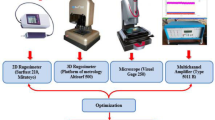Abstract
There exists an increasing demand for cost and time-efficient cutting tests for describing the performance of different combinations of cutting tools and workpiece materials in the cutting process both in industry and academia. Cutting tools are expected to withstand the heat and the pressure developed during the machining of difficult-to-machine materials such as Ti6Al4V. This article introduces a new test method which may be used in order to analyze both the machinability of a workpiece material as well as the cutting tool behavior. The experiments were performed by using a predefined sequence of feeds, a so-called Stepwise Increased Feed Test. A gradually increased load on the cutting edge was thus applied up to the point where plastic deformation of the cutting edge was obtained. The limit for the initial change in tool geometry was identified through analysis of measured cutting forces.
Similar content being viewed by others
References
Astakhov VP (2004) The assessment of cutting tool wear. Int J Mach Tool Manuf 44(6):637–647
Ezugwu EO, Da Silva RB, Bonney J, Machado AR (2005) Evaluation of the performance of CBN tools when turning Ti-6Al-4V alloy with high-pressure coolant supplies. Int J Mach Tool Manuf 45(9):1009–1014
Komanduri R, von Turkovich BP (1981) New observations on the mechanism of chip formation when machining titanium alloys. Wear 69(2):179–188
Machado AR, Wallbank J (1990) Machining of titanium and its alloys—a review. Proc Inst Mech Eng B J Eng Manufact 204(1):53–60
Ezugwu EO, Wang ZM (1998) Titanium alloys and their machinability—a review. J Mater Process Tech 68(3):262–274
Ezugwu EO, Bonney J, Yamane Y (2003) An overview of the machinability of aeroengine alloys. J Mater Process Tech 134(2):233–253
Hong SY, Ding Y (2001) Cooling approaches and cutting temperatures in cryogenic machining of Ti-6Al-4V. Int J Mach Tool Manuf 41(10):1417–1437
Vosough M, Kalhori V, Liu P (2004) Influence of high-pressure water-jet-assisted turning on surface residual stresses on Ti6Al4V alloy by measurement and finite element simulation. Proceeding of the 3rd International Surface Engineering Congress and Exposition, Orlando, pp. 107–113
Dalman P (2000) High-pressure jet-assisted turning chip control and temperature reduction. Doctoral Thesis, Department of Production Engineering, Chalmers University of Technology Gothenburg, Sweden
Jawaid A, Sharif S, Koksal S (2000) Evaluation of wear mechanisms of coated carbide tools when face milling titanium alloy. J Mater Process Technol 99(1–3):266–274
Meng Q, Arsecularatne JA, Mathew P (1998) Prediction of the cutting conditions giving plastic deformation of the tool in oblique machining. Int J Mach Tool Manuf 38(10–11):1165–1182
Nachev VI, Oxley PLB (1985) Predicting cutting conditions giving plastic deformation of the cutting edge in terms of tool and work material properties. Proceedings of the 25th International MTDR Conference, Macmillan, London, pp. 225–230
Trent EM (1968) Hot compressive strength of cemented carbides. Proceedings of the 8th International MTDR Conference, Manchester, pp. 629–642
Kuljanic E (1992) Macro plastic deformation of cutting edge—a method for maximum utilization of cutting tool. Annals of the CIRP 41(1):151–154
Ståhl J-E (1986) Skäreggars spontanhaverier. Doctoral Thesis, Division of Production and Materials Engineering, Lund University. (In Swedish)
Ståhl J-E (2012) Metal cutting—theories and models. Division of Production and Materials Engineering, Lund University in cooperation with Seco Tools AB
Spaans C (1967) The extra forces near cutting edge and their implications. International Conference on Manufacturing Technology, pp. 533–552
Spaans C (1971) The fundamentals of three-dimensional chip curl, chip breaking and chip control. Laboratorium voor werkplaatstechniek, Delft
Johnson GR, Cook WH (1985) Fracture characteristics of three metals subjected to various strains, strain rates, temperatures and pressures. Eng Fract Mech 21(1):31–48
Author information
Authors and Affiliations
Corresponding author
Rights and permissions
About this article
Cite this article
Vosough, M., Schultheiss, F., Agmell, M. et al. A method for identification of geometrical tool changes during machining of titanium alloy Ti6Al4V. Int J Adv Manuf Technol 67, 339–348 (2013). https://doi.org/10.1007/s00170-012-4487-3
Received:
Accepted:
Published:
Issue Date:
DOI: https://doi.org/10.1007/s00170-012-4487-3



